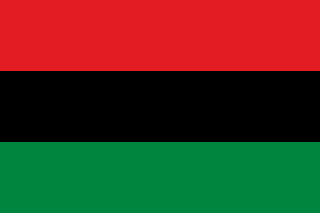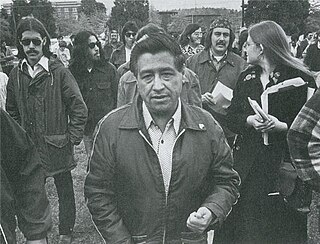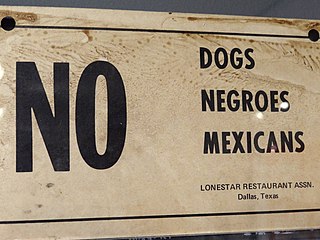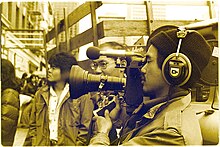Identity politics is politics based on a particular identity, such as race, nationality, religion, gender, sexual orientation, social background, caste, and social class. The term could also encompass other social phenomena which are not commonly understood as exemplifying identity politics, such as governmental migration policy that regulates mobility based on identities, or far-right nationalist agendas of exclusion of national or ethnic others. For this reason, Kurzwelly, Pérez and Spiegel, who discuss several possible definitions of the term, argue that it is an analytically imprecise concept.

Pan-Africanism is a worldwide movement that aims to encourage and strengthen bonds of solidarity between all indigenous peoples and diasporas of African ancestry. Based on a common goal dating back to the Atlantic slave trade, the movement extends beyond continental Africans with a substantial support base among the African diaspora in the Americas and Europe.

Yuri Kochiyama was an American civil rights activist. Influenced by her Japanese-American family's experience in an American internment camp, her association with Malcolm X, and her Maoist and Islamic beliefs, she advocated for many causes, including black separatism, the anti-war movement, reparations for Japanese-American internees, and the rights of political prisoners.

The Chicano Movement, also referred to as El Movimiento, was a social and political movement in the United States that worked to embrace a Chicano/a identity and worldview that combated structural racism, encouraged cultural revitalization, and achieved community empowerment by rejecting assimilation. Chicanos also expressed solidarity and defined their culture through the development of Chicano art during El Movimiento, and stood firm in preserving their religion.
The League of Revolutionary Struggle (Marxist–Leninist) was a Marxist–Leninist[1] movement in the United States formed in 1978 by merging communist organizations. It was dissolved by the organization's leadership in 1990.
TransAfrica is an advocacy organization in Washington, D.C. that seeks to influence the foreign policy of the United States concerning African and Caribbean countries and all African diaspora groups. They are a research, education, and advocacy center for activism focusing on social, economic and political conditions in Africa, the Caribbean, and Latin America and other parts of the African Diaspora. They are the largest and oldest social justice organization in the United States that focuses on the African world. They have served as a major research, educational, and organizing institution for the African and African Descendant communities and the U.S. public in general.
Chicano nationalism is the pro-indigenist ethnic nationalist ideology of Chicanos. While there were nationalistic aspects of the Chicano Movement of the 1960s and 1970s, the movement tended to emphasize civil rights and political and social inclusion rather than nationalism.
Panethnicity is a political neologism used to group various ethnic groups together based on their related cultural origins; geographic, linguistic, religious, or 'racial' similarities are often used alone or in combination to draw panethnic boundaries. The term panethnic was used extensively during mid-twentieth century anti-colonial/national liberation movements. In the United States, Yen Le Espiritu popularized the term and coined the nominal term panethnicity in reference to Asian Americans, a racial category composed of disparate peoples having in common only their origin in the continent of Asia.

Black–brown unity, variations include black-brown-unity[4][5] and black-brown-red unity,[6] is a racial-political ideology which initially developed among black scholars, writers, and activists who pushed for global activist associations between black people and brown people ,and Indigenous peoples of the Americas to unify against white supremacy, colonialism, capitalism, and, in some cases, European conceptualizations of masculinity, which were recognized as interrelated in maintaining white racial privilege and power over people of color globally.[7][8]

Asian/Pacific American (APA) or Asian/Pacific Islander (API) or Asian American and Pacific Islanders (AAPI) or Asian American and Native Hawaiians/Pacific Islander (AANHPI) is a term sometimes used in the United States when including both Asian and Pacific Islander Americans.
Wei Min She developed in the 1970s as an anti-imperialist organization in the San Francisco Bay area. When WMS first formed, many members identified themselves as Marxists and the group consisted of many different groups of people. They were primarily the working class, students and bourgeois.

Dragon Ladies: Asian American Feminists Breathe Fire is a book edited by Sonia Shah, published in 1997. The work contains a preface by Yuri Kochiyama and a foreword by Karin Aguilar-San Juan. The book is divided into four parts: Strategies and Visions, An Agenda for Change, Global Perspectives, and Awakening to Power, consisting of a collection of 16 essays and interviews by Asian American writers, artists, and activists presenting their views on feminism.
Revolutionary Action Movement (RAM) was a Marxist-Leninist, black nationalist organisation which was active from 1962 to 1968. They were the first group to apply the philosophy of Maoism to conditions of black people in the United States and informed the revolutionary politics of the Black Power movement. RAM was the only secular political organization which Malcolm X joined prior to 1964. The group's political formation deeply influenced the politics of Huey Newton, Bobby Seale, and many other future influential Black Panther Party founders and members.
The Asian American Political Alliance (AAPA) was a political organization started at University of California, Berkeley in 1968 that aimed to unite all Asian Americans under one identity to push for political and social action. The two main chapters were at UC Berkeley, and San Francisco State College, both of which became heavily involved in the larger Asian American movement throughout the 1960s, including at the Third World Liberation Front strikes at SF State and at UC Berkeley. The AAPA identified as an anti-imperialistic, Third World political organization that fought for self-determination and liberation for Asian Americans. They expressed solidarity and support for other people of color throughout the US and throughout the world, particularly in colonized or recently decolonized countries. The AAPA's participation in the Third World Liberation Front strikes at SF State and UC Berkeley resulted in the creation of a School of Ethnic Studies at SF State and an Ethnic Studies department at UC Berkeley. The AAPA was also involved in movements such as the Black Power Movement and the anti-Vietnam War movement. Although both main chapters were short-lived and disbanded in 1969, the AAPA played a large role in the Asian American movement and was influential in encouraging other Asian Americans to get involved in political action.

Asian American activism broadly refers to the political movements and social justice activities involving Asian Americans. Since the first wave of Asian immigration to the United States, Asians have been actively engaged in social and political organizing. The early Asian American activism was mainly organized in response to the anti-Asian racism and Asian exclusion laws in the late-nineteenth century, but during this period, there was no sense of collective Asian American identity. Different ethnic groups organized in their own ways to address the discrimination and exclusion laws separately. It was not until the 1960s when the collective identity was developed from the civil rights movements and different Asian ethnic groups started to come together to fight against anti-Asian racism as a whole.
Fashion activism is the practice of using fashion as a medium for social, political, and environmental change. The term has been used recurringly in the works of designers and scholars Lynda Grose, Kate Fletcher, Mathilda Tham, Kirsi Niinimäki, Anja-Lisa Hirscher, Zoe Romano, and Orsola de Castro, as they refer to systemic social and political change through the means of fashion. It is also a term used by some fashion designers, one being Stella McCartney. The spectacle of fashion activism as street protest has also been a theme in Paris Catwalk shows, perhaps most noted in Chanel's spring/summer 2015 show, designed by Karl Lagerfeld. The term is also popularly used by Céline Semaan, co-founder of the Slow Factory Foundation.
The Black Power Movement in Montreal in the 1960s was a period of rediscovering black identity through a process of invoking cultural, economic, and political thought amongst blacks. The eruption of political activism during Montreal's Quiet Revolution as well as the reformation of immigration policies which discriminated against non-white immigrants allowed black communities to publicly express and bring awareness to their struggles with racism. The movement was an integral component of the emerging global challenges to imperialism during the 1960s, stemming from various movements including Garveyism, pan-Africanism, the Harlem Renaissance, Rastafari, and others. Montreal's Black Power movement culminated in the aftermath of the Sir George Williams Affair—a student occupation that resulted in an estimated $2 million worth of damages and 97 arrests—which raised concerns of racism worldwide.
Feminism and racism are highly intertwined concepts in intersectional theory, focusing on the ways in which women of color in the Western World experience both sexism and racism.
Kazu Iijima was a Japanese American activist and community organizer who was a co-founder of Asian Americans for Action and the United Asian Communities Center.
In 1969, Shizuko "Minn" Matsuda and Kazu Iijima founded the Asian Americans for Action (Triple A or AAA) in New York City. The two women were inspired by the Black Power movement and originally planned a Japanese American political and social action movement, but ultimately chose to make it a pan-Asian organization, inviting members of all Asian ethnic groups to join. The story goes that it was Iijima's son, Chris Iijima, who convinced them to broaden their focus.










